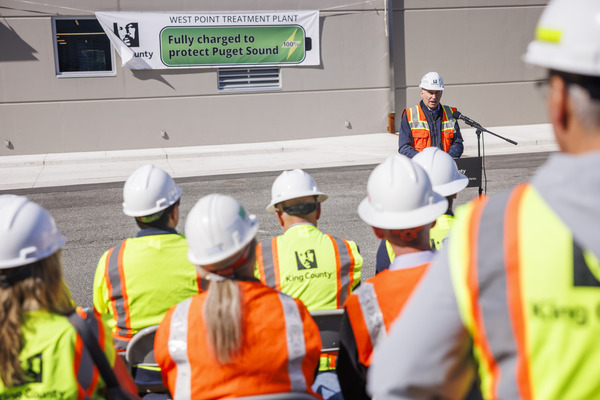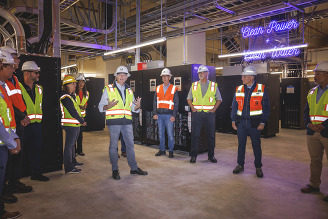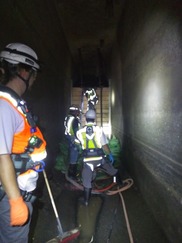|
 Image: Executive Constantine speaks at the ceremony.
We celebrated the completion of our new Power Quality Improvement (PQI) project at West Point Treatment Plant last month — just in time for the rainy season! The battery-based system, the first project of its kind in the United States, is now fully online, enhancing power reliability to the critical pump systems in the plant. This ensures continuous operation during power disruptions, preventing emergency bypasses of wastewater to Puget Sound, especially during severe storms.
The construction involved over 600 dedicated staff members and contract workers, and totaled 250,000 hours of work, delivering on King County Executive Dow Constantine’s emergency declaration to protect Puget Sound and prepare the facility for climate impacts. The ceremony brought together those who have played a pivotal role in the project’s success and recognized the project team for this monumental effort. Guests enjoyed hearing from speakers including Executive Constantine, U.S. Environmental Protection Agency Region 10 Administrator Casey Sixkiller, and Department of Natural Resources and Parks Director John Taylor, followed by a tour of the facility. This new building and system upgrade represents a major leap forward in our ability to maintain uninterrupted service and our ongoing clean water investments.
|
As we celebrate this achievement, we look forward to the continued improvements it will bring and the positive impacts on our plant's operations. Here’s to a brighter future!
Image: Project staff gather under the neon lights celebrating clean power and clean water.
|
|
 |
|
|
 Image: Staff set a solar panel in place on the roof of the Power Quality Improvement Project building at West Point Treatment Plant.
Beyond the batteries, the new PQI building is also charging up on solar power. Perched on top of the building are 140 gleaming solar panels. The 80-kW installation helps to power the lighting and heating, ventilation, and air conditioning (HVAC) system in the battery building so that the batteries themselves can focus on providing power to the plant during disruptions. Opportunities like this — turning a sun-soaked roof into a renewable energy powerhouse — are part of King County Wastewater Treatment Division’s (WTD’s) efforts to pack sustainability into our operations, especially as new projects come online.
While biogases produced during the wastewater treatment process remain our main source of energy production (we even sell it back to the natural gas system!), solar offers another complementary energy source to add to the mix. Treating wastewater is an energy-intensive process, and integrating more solar power is one tool to lower our energy footprint. This will make a significant dent in the County’s Strategic Climate Action Plan (SCAP) to install collectively 1.5 megawatts (MW) of solar power by the end of 2025. Our goal is to install at least 375 kilowatts (kW) of solar capacity by 2025, with a vision to scale up to 600 kW by 2030.
Meet us at Magnolia Farmers Market this weekend
Image: Shoppers visiting the Magnolia Farmers Market.
King County staff will be at the Magnolia Farmers Market this month to share how WTD is protecting public health and the environment while improving water quality in the Puget Sound. Stop by our table for fun facts and more details about:
-
What to flush in King County’s sewer system
-
WTD’s Workforce Development Program and Operator-In-Training program
-
Important updates on current and future West Point Treatment Plant projects
-
Wet weather preparedness tips and tricks
You can catch us on Saturday, Oct. 5 from 10 a.m. to 2 p.m. We hope you can join us!
|
|
 |

Image: "It's Salmon SEEson again" graphic
The West Point Outreach Team will be joining our colleagues from the RainWise Program and Seattle Parks at Piper’s Creek in Carkeek Park on Nov. 23 from 11 a.m. to 2 p.m. for the Salmon Celebration event. Come see returning Chum and Coho salmon and learn how King County and Seattle are continuously improving our water and habitat with the help from communities like you!
You can learn more about Salmon SEEson and find other locations all around King County to watch salmon return home throughout the fall at King County’s Salmon SEEson webpage.
|
|
|
 |
|
Image: Earthquake safety tips graphic to secure your home: Bolt tall furniture, secure loose objects, and know how to turn off utilities. |
September was Natural Disaster Preparedness Month! Here at West Point Treatment Plant, we’re preparing for the future with upgrades to increase resiliency against earthquakes, heavy rainfall, sea-level rise, and other natural disasters.
The month served as a reminder to everyone to be prepared for disasters or emergencies in your homes, businesses, and communities. Identifying potential hazards ahead of time and advance planning can reduce the dangers during an emergency. You can learn more about how to prepare for disasters at the King County Emergency Preparedness page.
October 17 is the great ShakeOut – where you can participate with millions of other people around the world in an earthquake drill. Learn more about the Washington ShakeOut and what to do during an earthquake.
Image: Partner with King County WTD to be part of our mission to protect public health and the environment.
King County Wastewater Treatment Division is pleased to extend the opportunity to apply for Partners in Water collaboration grants. This grant program connects King County with non-profit organizations to better serve community needs and improve our mission to protect public health and the environment.
New Deadline: October 14, 2024, by 11:59 PM
Who Can Apply? Organizations must be located in the King County Wastewater Treatment Division service area and have or be able to secure 501(c)(3) nonprofit status.
Who Should Apply? We encourage applications from organizations serving communities facing historic and current inequities, including BIPOC communities, immigrants and refugees, low-income individuals, LGBTQIA+ individuals, and people with disabilities.
The grants will support two pilot projects:
- Career Pathways Program (2 grants of $25,000): Work with our Human Resources to create job opportunities and support job seekers in your community.
- Guidance Toolkit for Community Partnerships (4 grants of $27,500): Partner with our Community Services team to inform systems transformation in community partnerships.
 |
|
Upgrading the Old Fort Lawton Tunnel
Image: Crews go inside the old Fort Lawton Tunnel to repair the expansion joints.
We’re constantly looking for opportunities to upgrade our historic infrastructure through our capital improvement projects. For example, crews recently completed work in the old Fort Lawton Tunnel. This tunnel was a major reason why a treatment plant was put where West Point is today. Crews were replacing the expansion joints in the tunnel. The expansion joints allow for safe movement of materials while maintaining structural integrity. This work involved installing temporary walls to reroute wastewater from the tunnel during the work. The work was completed safely and ahead of schedule in September and is part of our larger
|
|
|
Fun fact
Did you know that West Point Treatment Plant is actually older than Discovery Park? The facility opened and began operating in 1966. While Discovery Park has its history as Fort Lawton since pre- World War I, it did not officially become the park it is today until 1972, when the Fort Lawton Park Master Plan was submitted to the City of Seattle and dedicated as Discovery Park a year later. Prior to being a park, the area was part of the Fort Lawton Army Base, established in 1900. The Fort housed troops for both world wars and prisoners of war during World War II.
|
|
Image: Construction of the new Fort Lawton tunnel in 1991.
Image: A man stands in front of the 12-foot diameter terminus of the old Fort Lawton Tunnel.
|
|
|
|
|